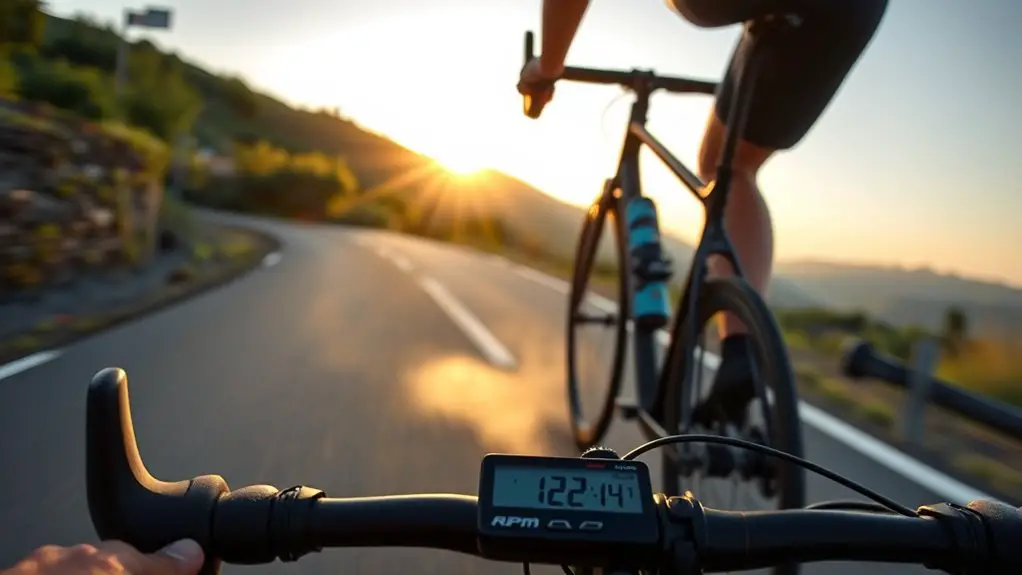Cadence drills are essential for time-trial cyclists because they boost your cycling rhythm and enhance power output. By practicing different cadence techniques, you can improve your pedal stroke efficiency and reduce fatigue. Incorporating these drills helps you maintain a steady cadence, which translates to higher speeds and less energy waste. Mastering your cadence can make a significant difference in your performance. Discover how to effectively integrate these drills into your training plan for maximum benefits.
Understanding Cadence and Its Importance in Time-Trial Cycling
Cadence, or the rate at which you pedal, plays a crucial role in time-trial cycling. It's about finding your rhythm, a flow that releases your potential and enhances your cycling performance. When you focus on maintaining an ideal cadence, you'll discover a range of cadence benefits. For starters, it helps you achieve a more efficient power output, allowing you to ride longer without fatigue. A steady cadence can also improve your speed and minimize energy wastage, giving you that exhilarating freedom to conquer the road.
As you experiment with different cadences, you'll find what suits your style best. Whether you prefer a higher cadence for quick bursts or a lower one for endurance, understanding this aspect of cycling will set you free on the bike. Embrace the journey of mastering your cadence, and watch your performance soar as you push the limits of what you thought possible. Additionally, staying hydrated is essential for maintaining your optimal fluid needs during intense rides.
Types of Cadence Drills to Incorporate Into Your Training
To enhance your cycling performance, incorporating various cadence drills into your training routine can make a significant difference. Here are some effective types of cadence drills to try:
- High Cadence Intervals: Push your limits by cycling at a high cadence (90-110 RPM) for short bursts, followed by recovery periods. This builds speed and efficiency.
- Low Cadence Strength: Focus on lower cadence (60-70 RPM) while increasing resistance. This helps develop leg strength and muscle endurance, essential for time trials.
- Cadence Pyramid: Gradually increase your cadence every minute, then decrease. This drill teaches you to adapt to changing speeds.
- Single-Leg Drills: Pedal with one leg for a few minutes, then switch. This improves balance and isolates muscle groups, helping you maximize your pedal stroke.
Incorporating these drills will give you the freedom to ride stronger and faster!
How Cadence Drills Improve Pedal Stroke Efficiency
Improving your pedal stroke efficiency is essential for maximizing power output and minimizing fatigue during time trials. By incorporating cadence drills into your training, you can enhance your pedal stroke mechanics, leading to significant efficiency gains. These drills focus on maintaining a consistent and ideal cadence, which helps you develop a smoother, more controlled pedal stroke.
As you practice, you'll learn to engage the right muscle groups more effectively, reducing wasted energy and enhancing your overall performance. With better pedal stroke efficiency, you'll find yourself able to sustain higher speeds for longer durations, giving you that exhilarating sense of freedom on the road. Moreover, improved cadence allows for a seamless shift between different terrains, helping you tackle climbs and descents with ease. Embrace these drills, and you'll reveal your potential, making every ride feel like a liberating journey toward your goals. Interval training can also be an effective method to boost your overall endurance, complementing your cadence drills.
Monitoring Progress: Tools and Techniques for Measuring Cadence
As you work on enhancing your pedal stroke efficiency, keeping track of your cadence becomes essential to understanding your progress. By monitoring your cadence, you can reveal insights that lead to greater performance. Here are some tools and techniques to help you measure your cadence effectively:
- Cadence Sensors: These devices attach to your bike or shoe, providing real-time data on your pedal revolutions.
- Cycling Computers: Many GPS cycling computers offer cadence tracking alongside other performance analytics, making them versatile.
- Smartphone Apps: There are numerous apps designed for cyclists that can record and analyze your cadence during rides.
- Power Meters: Not only do they measure power output, but many also provide cadence metrics, giving you an all-encompassing view of your cycling efficiency.
Incorporating tools with accurate heart rate monitoring can further enhance your training by allowing you to gauge intensity during your rides.
With these tools, you'll be well-equipped to monitor your cadence and refine your training strategy.
Integrating Cadence Drills Into Your Overall Training Plan
Integrating cadence drills into your overall training plan can considerably enhance your cycling performance, especially when you strategically incorporate them alongside endurance and strength workouts. By focusing on cadence variability, you'll not only improve your pedaling efficiency but also build muscle memory for a more powerful stroke.
Start by dedicating specific sessions to cadence drills, mixing them with your regular rides to maintain training consistency. For instance, you might include high-cadence intervals during your endurance rides or integrate them into strength training sessions. This approach helps your body adapt to varied rhythms and conditions, giving you the freedom to adjust your cadence naturally during time trials. Additionally, incorporating mobility training into your regimen can further enhance your overall performance by improving range of motion and reducing injury risk.
Frequently Asked Questions
How Often Should I Practice Cadence Drills Each Week?
How often you practice cadence drills each week can really depend on your overall training goals. Ideally, aim for 2 to 3 sessions weekly to keep your cadence frequency in check. You might consider a practice schedule that mixes in these drills with your regular rides, so you're not feeling overwhelmed. This way, you can enjoy the freedom of varied workouts while still improving your cycling efficiency over time.
Can Cadence Drills Benefit Non-Time-Trial Cyclists?
Ever wondered if cadence drills could actually make a difference for you, even if you're not a time-trial cyclist? You might be surprised! These drills can boost your cycling efficiency, helping you pedal smoother and faster. Imagine feeling that freedom as you glide through your rides with less effort. The cadence benefits extend to everyone, improving endurance and strength. So, why not give those drills a shot and release your potential on the road?
What Is the Ideal Cadence Range for Time-Trial Cyclists?
For time-trial cyclists, the ideal cadence typically falls between 80-100 RPM. This range helps you maintain efficiency while minimizing fatigue. You'll notice that higher cadences can enhance your speed, but they might also increase the risk of burnout. Experimenting within this range allows you to feel the cadence effects on your performance and comfort. Ultimately, finding your sweet spot not only boosts your power but also gives you the freedom to ride longer and stronger.
Are There Specific Shoes That Enhance Cadence Performance?
Imagine a bird in flight, gliding effortlessly through the skies, its wings crafted from the lightest materials. Just like those wings, the right cycling shoes can enhance your pedal efficiency, allowing you to soar without resistance. Look for shoes made from breathable, lightweight materials that offer a snug fit. With the right shoes, you'll find freedom in your cadence, revealing your potential and making each pedal stroke feel like a dance through the wind.
How Do I Prevent Fatigue During Cadence Drills?
To prevent fatigue during cadence drills, you should focus on hydration strategies and recovery techniques. Staying hydrated keeps your muscles functioning at their best, so sip water before, during, and after your drills. Incorporate short breaks to let your body recover and stretch out tight muscles. Remember, it's about finding a rhythm that feels good for you. Listen to your body, and don't push too hard—freedom in cycling comes from balance and awareness.




